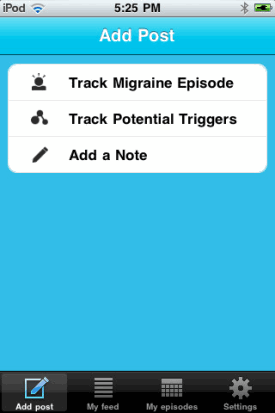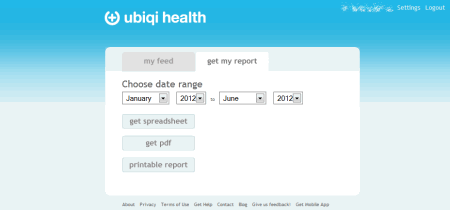Review: Ubiqi Health Migraine Tracker
I really wanted to like the Ubiqi Health app for tracking your migraine attacks. Well actually, I do like it – really with only one exception. And for many users, that exception won’t matter. But we’ll get to that in a moment.
What is the Ubiqi Health Migraine Tracker?
The Ubiqi Health Migraine Tracker is an app for your iPod, iPhone, IPad, Android, Blackberry – well, for your various gadgets – to help you track your migraine attacks. But that’s not all.
The Ubiqi app helps you track things that may be triggering migraine attacks, and also the duration of your attacks, the frequency, and even what treatments work or don’t work.
For many years we’ve talked about the importance of keeping track of your migraine attacks, along with triggers and treatments when possible. Whether you do it electronically or on paper, it’s helpful for you and your health providers as you seek the best treatment.
This app is an excellent way to do that. If you’re a smart phone or iPod user, you’ve got your tracker right with you. You can also use it on your desktop, and even print out reports for a specific time period.
A closer look…
But let’s take a closer look at the app.
First, you’ll need to register. Of course, all your health information is totally private – this allows your information to be backed up so that you can access it in multiple locations and restore it to your app itself.
 |
Then you’ll have the option to track a migraine episode, track potential triggers, or add a note.
The challenge with writing a review like this is that it’s easy to make it sound more complicated than it is. The beauty of this app is that it’s very easy to use.
When you enter a migraine episode, you simply enter the date and time (the app assumes the episode is happening now, but you can change the start and end of the attack any time), then you can also enter pain intensity, treatments, potential triggers and notes.
You can do this all very quickly because you can enter treatments and triggers ahead of time. For example, if your doctor prescribes Frova for your attacks, you can enter that into the app along with the dosage, and you’re good to go.
So usually all you have to do is tap, tap, tap and before you know it you’re done.
Obviously this is a book for migraineurs who don’t want to do anything during a severe attack!
However, during or after an attack you can add notes – which makes this app extremely flexible.
Now, you’ve been using it for a while – what can you do with the information?
You can quickly see all attacks on a calendar, or in a list with more detail. You can view it on your smart phone or online anywhere.
Then – and this is beautiful – you can get a report.

As you can see, you can get a spreadsheet, a pdf file, or a printable report that you can view right in your browser.
The report will show you a chart with dates and pain intensity, so you can see at a glance how you’ve been over that period. Then it will break it down into a table, so you can see what treatments worked or didn’t work, and what migraine triggers were most common.
Of course, you can print this and show it to your doctor – or even a spouse, or friend.
As you can see, this can be a powerful tool!
You’re no longer guessing – you can see at a glance exactly what has worked and what hasn’t.
So what’s the problem?
For some migraineurs, this app would be almost perfect (I hate to call anything 100% perfect!).
But for some – there’s something lacking. And actually, I think it could be implemented into the app, and I’d like to recommend it.
The problem is that the migraine attacks are broken up into "episodes" (fair enough), and these episodes have a level of pain intensity. But you can only choose one level.
(Side note: I prefer to record symptom or discomfort intensity, because migraine symptoms are more than just pain. Some people may find that recording pain is enough, but you can easily use the app to record your symptom level, or disability level. It’s just how you use it.)
The problem comes when an attack lasts for more than one day. The level of pain (or symptoms) may vary quite a bit over the course of a day or two days. That information can be very important.
And when you’re a chronic migraineur, you could possibly have longer bouts with pain – a week, or even constantly.
In this case, the varying level of pain/symptoms becomes a critical thing to record. And this is a key audience who would really appreciate this app.
Now you can work around this somewhat, by simply entering different episodes based on the level of pain. What you’ll do is enter separate episodes one after another. And it works fine, and you may choose to do it that way and have no problem.
But in my opinion it would be better to merge those into one "episode", or into one day, because otherwise it’s a little confusing trying to track the treatments and triggers – because now you may be taking one treatment for multiple episodes in one day, for example. (For constant migraine pain, for example, it might be nice to see morning, afternoon, and night, with different symptom levels, but all together day by day – rather than listing 3 completely separate episodes.)
One reviewer on the app store noticed the same thing from a different standpoint. If a migraine attack lasts for more than one day, there’s only a "dot" on the chart for the first day. Hey, some people would only get dot per year! 🙁
For some, this may make the app unusable. But for many, this won’t be an issue at all.
Still, I think that the designers of this app should be able to make the change to make this app perfect almost perfect for everyone. 😉
Summary
For many migraineurs, this will be just what you need to really take control of your treatment. That may seem like a strong statement, but simple tracking of our treatments, triggers and symptoms is the weakest link for many of us.
 |
For most, it will simply be a matter of preference. Some prefer paper, others prefer to track using their favourite gadget. Whatever makes you actually do it – use that thing!
Thanks to Jacqueline Thong and her team at Ubiqi Health for putting together an easy to use – and still very useful – app.
Try it today! It’s free!

2 July 2012 @ 7:34 pm
I couldn’t agree more with the problem with the product! Most of my migraines are longer than one day and they almost always vary in intensity from day-to-day and at different times of the day, so that would be a critical revision!